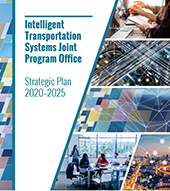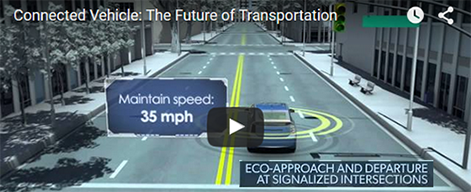News & Information
Dynamic Mobility Applications
VISION
The vision of the Dynamic Mobility Applications program is to expedite the development, testing, commercialization, and deployment of innovative mobility applications, fully leveraging both new technologies and federal investment to transform transportation system management, to maximize the productivity of the system, and enhance the accessibility of individuals within the system.
Dynamic Mobility Applications is a major initiative of the U.S. DOT multimodal initiative led by the Intelligent Transportation Systems Joint Program Office (ITS JPO) within the U.S. Department of Transportation (U.S. DOT) Research and Innovative Technology Administration (RITA). The U.S. DOT is focused on making surface transportation safer, smarter and greener by leveraging wireless technology capabilities in an interoperable communications network environment to provide safety, mobility and environmental benefits to the transportation community and the traveling public.
Dynamic Mobility Applications capitalize on vehicle-infrastructure connectivity such as data from vehicle probes and other real-time data sources, using Dedicated Short Range Communications (DSRC) and other wireless communications methods. The vision for dynamic mobility applications research is to provide significant improvements to mobility and accessibility by introducing innovative methods for operating existing transportation systems based on the availability of new data sources and communications methods, and by creating opportunities for greater integration across modes (e.g., light vehicles, transit vehicles, and heavy commercial vehicles).
RESEARCH PLAN
The objective of the Dynamic Mobility Applications program is to foster the development of open source applications that utilize multi-source ITS data to transform surface transportation management and information. The research conducted in this program will identify high-value applications for research and develop the tools, metrics, and concepts that form the foundation for future application development.
The applications that have been and will be evaluated are those that enable public sector, multimodal system management and:
- Use vehicle and infrastructure connectivity and data to enable dynamic decision making.
- Allow traffic managers to anticipate problems, be proactive in addressing issues, and rapidly monitor impacts on and across multimodal transportation networks.
- Support emerging work in decision support systems, systems that can assimilate and analyze large volumes of detailed real-time and historic data to provide recommendations in formats that are most valuable to traffic managers or travelers.
INITIAL STEPS IN THE RESEARCH PROGRAM
- Define multimodal performance metrics that form the basis for decision support systems, tools, and models.
- Collect real-time data for assessment (to include collaboration with the Real-Time Data Capture and Management program).
- Assess data from historical and real-time traffic and travel behavior perspectives to understand which types of multimodal data enable dynamic, proactive decision making.
- Identify which public sector, multimodal dynamic applications might be of highest value and use demonstrations to test the validity of those assumptions with stakeholders.
RESEARCH INCLUDES
Track 1: Engage stakeholders for input across all phases, from foundational analysis to focused demonstrations.
Track 2: Conduct program planning and coordination including fundamental research and development, institutional policy, and standards that will ultimately enable public and private sector applications development, and support application impact assessments, while using communications across interoperable platforms.
Track 3: Conduct applications development and testing for the standards, algorithms, tools, and protocols that will be needed for implementation of the applications.
Track 4: Conduct focused demonstration and analysis based on a partnership with the Real-Time Data Capture and Management and the AERIS (Applications for the Environment: Real-time Information Synthesis) programs to demonstrate applicability in a market-based environment and assess quantifiable benefits. This track includes conducting a near-term demonstration of market-ready technologies and applications.
Track 5: Develop evaluation and performance measures that address the performance of both the applications developed, as well as the program itself.
Track 6: Coordinate outreach and technology transfer to inform the transportation community on the activities of the program, and share findings and procedures with stakeholders.
Research Goals
- To identify transformative applications and innovative methods to manage and operate transportation systems based on the availability of new data sources and communications methods.
- To build on application data integration foundation to transform the data into information that can provide travelers and system operators greater access to real-time information about the transportation system to enable better decision making.
Research Outcomes
- The results of this research will provide the foundation (the concepts, requirements, specifications, analyses, tests, and metrics) needed for development of dynamic mobility applications.
Examples of Multimodal Dynamic Mobility Applications
- Measurement and prediction of system performance using probe data generated through DSRC and non-DSRC technologies.
- Increasing intersection safety and efficiency through traffic signal phasing and timing (SPaT) and geospatial information technology.
- Road weather management applications to respond to or anticipate the effects of weather on roads to increase mobility and safety.
- Transit management and freight operations increase efficiency, thus reducing costs and congestion.
- Dynamic, real-time route planning and adjustments to emerging incidents.
- Advanced parking management systems and Integrated Corridor Management.
Real-time data and communication networks are critical to the development and deployment of new DMA applications.
To learn more about the Dynamic Mobility Applications program, contact:
Katherine K. Hartman
Program Manager
ITS Joint Program Office
Research and Innovative Technology Administration
(202) 366-2742
kate.hartman@dot.gov
Robert Rupert
Traveler Information Management Team
Office of Transportation Management
Federal Highway Administration
(202) 366-2194
robert.rupert@dot.gov
Steven Mortensen
Office of Mobility Innovation
Federal Transit Administration
(202) 493-0459
steven.mortensen@dot.gov










